Freshness matters most with seafood, which helps to explain why, a few generations ago, the culinary taste of most Americans stopped at the water’s edge. Unless you lived near a port or a well-stocked river, bay or lake, most of your seafood came out of a can. Even today—after breakthroughs in flash freezing and rapid transport—many of us who enjoy sushi, ceviche or an array of fish and shellfish entrées at a restaurant shy away from all but the simplest seafood preparations in our homes. It’s as if an atavistic reaction to the otherness of the underwater world makes us uneasy—if not downright queasy—when faced with the reproachful glance of a glassy-eyed sea bass staring up at us from the cutting board.
Ben Pollinger, the executive chef at Oceana, New York’s prestigious seafood restaurant, wants to change all that. In “School of Fish” (Gallery, 448 pages, $35), he provides home cooks with a crash course in seafood basics, such as selection, storing and prep techniques, together with more than 100 recipes. The recipes range from the simple—e.g., Sea Scallop Crudo, with nothing more added to raw scallops than lemon juice and zest, parsley, a splash of olive oil and a dash of sea salt—to the complex, like an herb-, onion- and garlic-laden, anisette- and wine-boosted, saffron-infused Monkfish Bouillabaisse.
For many readers, the most valuable sections of “School of Fish” will be those dealing with practical advice on how to select, store and prep seafood in the first place. Whether you’re buying a whole fish, fillet or steaks, Mr. Pollinger explains, “look for fish that sparkles. As the fish ages, the sparkle dulls noticeably. On whole fish, the skin should be shiny. Pull open the flap that covers the gills and take a look—the gills should be bright red, not brown. The eyes should be bright, not clouded.” Fish fillets and steaks should “gleam” and “look moist and translucent.” When cooking fish, doneness can be detected tactilely (the softer the fish is to the touch, the rarer it is) or visually (the longer fish cooks, the more its flesh turns opaque).
Part of the pleasure of seafood is its variety, Mr. Pollinger writes, but the variety can be confusing. Hamachi, a sushi mainstay, is also known as Yellowtail, while Sablefish, a deli staple in its smoked form, is sometimes marketed as “black cod,” even though it is unrelated to codfish. To help readers make sense of all this, the author appends a “Fish-ionary” describing fish varieties by name and category. He also offers a step-by-step, photo-illustrated guide to shucking bivalves, filleting whole fish and preparing live crustaceans for the oven, grill or pot. While novices may balk at vivisecting a live soft-shell crab by lopping off its eyes, slashing away its gills and tearing off part of its shell, the task should become easier over time.
Mississippi-born Ben Mims is another food professional who writes about his subject with affection and expertise. “Sweet & Southern” (Rizzoli, 224 pages, $39.95) is a paean to the rich—sometimes all-too-rich—delights of Southern desserts. But in Mr. Mims’s case, love is not blind. While he treats us to scores of Dixie classics, he brings a light, imaginative touch to many of them.
An upside-down-cake, for instance, substitutes fresh cantaloupe for the usual tinned pineapple; an imaginative take on Austrian-inspired Linzer Torte uses tangy American cranberries and piquant Southern pecans instead of the traditional raspberries and hazelnuts; and an updated peanut-butter pie minimizes the usual pudding and whipped-cream fluff while maximizing the peanut flavor.
Of course some classics would only suffer from tampering. A recipe for peach ice cream rightly concentrates on the rich essentials—fruit, cream and egg yolks—with a splash of peach schnapps and a dash of sea salt heightening the flavor. Another classic is Strawberry Grunt. Despite the appellation, this is a happy matching of fruit and cream in the form of “bubbling strawberry jam beneath sweet cream biscuits.” Whether he is writing about watermelon gelatin or sweet-potato cake, Mr. Mims approaches his subject with kitchen know-how and contagious enthusiasm.











